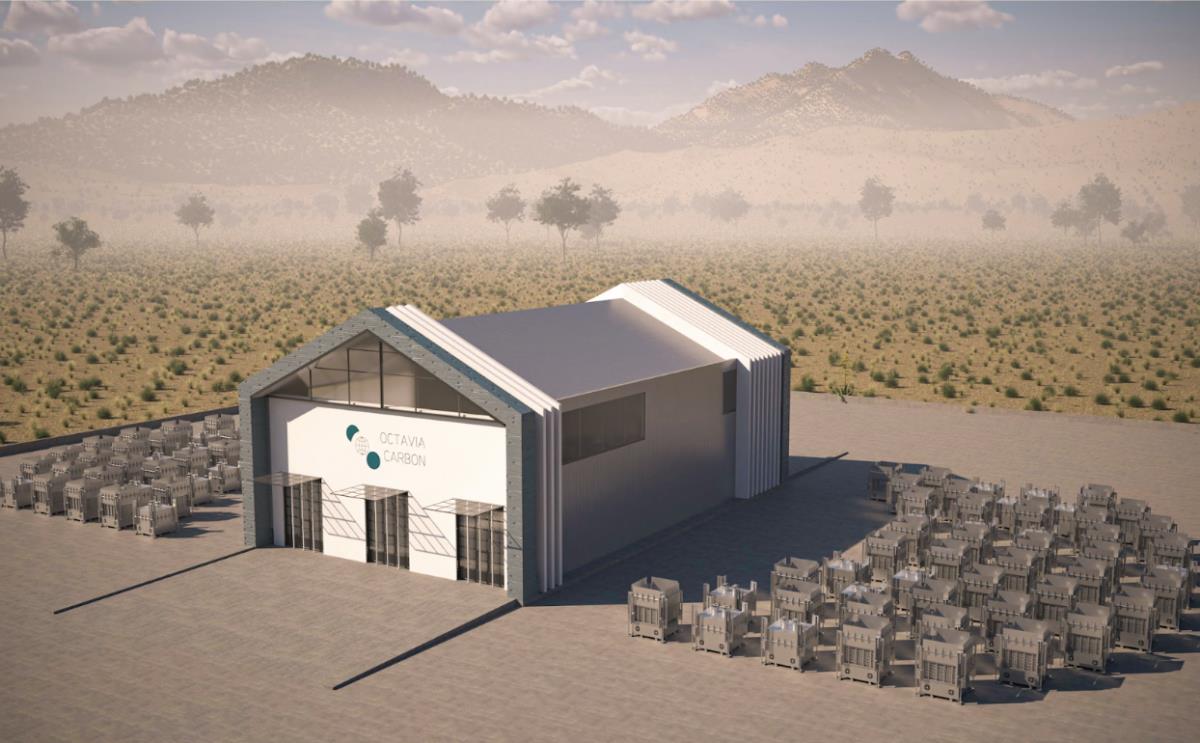
How Octavia Carbon Is Unlocking Africa's DAC Potential: In Conversation With Climate Vault
Picture this: a dedicated team of visionaries, armed with ingenuity and determination, crafting cutting-edge machines designed to extract CO2 straight from the air around us. But award honoree Octavia Carbon isn't just focused on developing new technology; it's also catalyzing positive change for the planet and local community.
As the Global South's first Direct Air Capture (DAC) company based in Nairobi, Kenya, Octavia Carbon designs, builds, and will soon deploy machines that filter CO2 from the atmosphere. By leveraging Kenya's renewable energy, geology, and talent, they aim to not only drive down the cost of DAC but also promote socio-economic growth within the region.
In the interview below, Martin Freimüller, CEO & Co-Founder, shares about Octavia Carbon's mission to reverse the effects of climate change and end the fossil fuel age by deploying competitively low-cost, geothermal-integrated DAC in Kenya. You can also register to attend Climate Vault's upcoming webinar on September 11 to hear from Martin firsthand about Octavia's first-of-its-kind DAC operations.
Can you tell us about your background and role at Octavia Carbon?
My name is Martin Freimüller, and I am the CEO & Co-Founder of Octavia Carbon. After a working-class upbringing in Austria, I had the opportunity to spend two years of my youth in South Africa and Zambia. Realizing how much economic opportunity goes underleveraged in much of the African continent, I studied Politics and Business at Cambridge and then went into international development consulting with Dalberg.
What was the inspiration behind launching Octavia Carbon and pursuing innovative carbon removal solutions?
At Dalberg, I realized that CDR, as a major emerging industry, can be a key job driver on the African continent and that Kenya specifically is the world's best place for DAC. Kenya is truly unrivaled in having the best energy, geology, and talent to scale DAC massively. With this in mind, I decided to use my COVID savings to move to Kenya and establish a DAC company and industry in late 2021. In June 2022, my co-founders and I started Octavia Carbon as a seemingly wild idea at a kitchen table. We have since grown to a team of more than 55 and are developing a pilot DAC+Storage plant, Project Hummingbird (see image 1), that will have the capacity to capture and securely store more than 10,000 tons of CO2 over ten years.
What makes Octavia Carbon's approach to carbon removal so unique and credible?
Our approach stems from our strong conviction that Kenya is the best place for DAC deployment. The country's endowments are key (and favorable) to developing, deploying, and scaling our technology. For DAC to be efficient, it needs to operate in regions with excessive renewable energy. Kenya is one such country where, in the geothermal sector alone, 1,000 MWh of electricity is curtailed daily due to the lack of industrial demand.
Most importantly, we have designed our DAC technology to harness Kenya's geothermal potential to overcome the energy requirements of DAC. Typically, in DAC, a chemical filter (or 'sorbent') is used to selectively isolate CO2 from the atmosphere. Once saturated, the filter is heated to release the captured CO2 and regenerate for subsequent use. At the core of our DAC approach is a patent-pending sorbent, developed in-house, that regenerates at temperatures of ~85°C. This key factor allows us to integrate our DAC technology with Kenya's cheap, abundant geothermal waste heat that would otherwise remain vastly untapped. The waste heat will cater to >80% of our energy needs for our pilot plant, and geothermal electricity will account for only <20% of our DAC energy needs.
Furthermore, Kenya's geological formations along the Rift Valley, particularly the basaltic rocks, provide an ideal permanent storage solution for our captured CO2 through mineralization. Leveraging this geologic formation, our storage partner will inject the captured CO2 underground for safe and secure permanent storage.
Lastly, thanks to Kenya's relatively low manufacturing base, we have been able to marshal more brains and hands into our technology development process. This has allowed for faster iteration, granting us faster learning curves than our industry peers.
How do you envision your DAC technology contributing to mitigating climate change on a global scale?
Climate science is clear: to mitigate the effects of climate change, we need to remove 5-10 billion tons of CO2 from the atmosphere annually by 2050 to keep global warming below 1.5°C. DAC, we believe, is the gold standard of CDR. This is mainly because DAC is highly measurable and scalable, and the CO2 captured can be durably stored. Project Hummingbird, with an initial capture and storage capacity of 1,000 tons of CO2 in a year, will serve as a benchmark and inform our future scaling plans. By 2030, we aim to have removed more than a million tons of CO2 from the atmosphere and to be at the forefront in driving the transition to a net-zero future.
Are there other potential benefits, environmental or otherwise, of widespread adoption of your project?
With 1,000 MWh of geothermal electricity wasted daily, electricity costs in Kenya remain high for the regular Kenyan, who has to bear the costs of the excess capacity produced. Our DAC operations will create the demand for the excess capacity and incentivize the build-out of the renewables sector. Through this, our operations will potentially subsidize electricity costs for the end consumers and increase energy access, especially for rural communities.
We are committed to making Kenya a DAC hub by fostering collaboration and public understanding of DAC and lobbying for favorable DAC policies with the respective Kenyan ministries to encourage industry growth within the region. We are already working with local research institutions and universities to improve our technology and train the next generation of DAC experts through educational programs and outreach initiatives.
Kenya and the African continent at large have contributed little to climate change, but its effects have had devastating consequences on communities in the country. Our deployment region is mainly home to the local Maasai people, whose traditional pastoralist livelihoods have been stripped by prolonged droughts in Kenya. Beyond job creation (see image 2), our pilot project aims to promote climate justice in the region by allocating a portion of the revenue to local initiatives through a comprehensive community benefit plan. These initiatives will address major challenges these communities face, such as water scarcity and high illiteracy levels.
What have been some key milestones or breakthroughs for Octavia Carbon?
In our two years of existence, we have designed and built seven at-scale machines, which are among the fewer than 50 DAC machines available globally. We have also grown our team to >55 young, talented Kenyan innovators determined to build globally competitive technology in Kenya.
Our first model, Thursday – 1tCO2/yr, was open-sourced through the Open Air Collective and has since been referenced by DAC enthusiasts globally. The Lenana model (see image 3) -10tCO2/yr is currently being iterated before we transition to its mass production. We are building a mini-DAC demonstration plant in our Nairobi facility to stress-test the Lenana models already built and validate our plant designs for Project Hummingbird at a small scale. Project Hummingbird will commence operations in Q4 this year and will be the first DAC+Storage facility in the Southern Hemisphere. We have already pre-sold 15% of the plant's capacity, equivalent to ~1.1M in revenue, to highly catalytic buyers like Klimate, Klarna and Terraset.
Can you share some of the main challenges you've encountered during the development and implementation of your pilot plant, Project Hummingbird, and the lessons you have learned along the way?
My experience building the Global South's first DAC company has taught me the importance of building strong networks. These networks have been crucial in navigating the complex landscape of climate innovation in the Global South. By forming strategic partnerships and collaborations, we have gained access to invaluable resources, expertise, and support. These connections have not only accelerated our growth but have also opened new doors to opportunities and pathways for impact. As we expand our reach and influence, nurturing and fostering these networks remains essential to our success.
Access to funding has also been a constraint to our journey in developing Project Hummingbird. We are lucky to have early-stage investors who have allowed us to develop the technology and de-risk it for follow-on investors. However, the pool of investors who invest both in deep climate tech and in Africa remains limited. We hope that our success in scaling DAC in Kenya will unlock a lot more funding for ourselves and future innovators in the African climate tech space.
What is your hope for the future of carbon removal technologies, and how does Octavia Carbon fit into that vision?
Our hope for the future of carbon removal technologies is that their supply will grow with a negative cost curve so we can achieve net zero and begin reversing climate change for future generations. Beyond the core climate benefit, we also hope that carbon removal technologies will be a new economic driver, particularly in regions like Africa that are still developing. We believe that our DAC operations in Kenya will create a new economic engine that will help drive green industrialization in the region and create prosperity for local communities.
What can individuals, businesses, and policymakers do to support the development and adoption of carbon removal technologies such as yours?
Individuals can play a part in supporting the development and adoption of carbon removal technologies like DAC by raising awareness about their importance. They can also advocate for policy change to incentivize the development and deployment of these technologies. Businesses can support DAC companies by procuring DAC carbon credits to offset their emissions and also mobilizing investments into DAC projects. This can create a more favorable environment for DAC companies to operate and scale their solutions.
Policymakers can help accelerate the adoption of carbon removal technologies like DAC by implementing policies and regulations that create a healthy business environment to attract investments into the sector. This may include tax breaks, subsidies, and streamlined permitting processes.
Here at Climate Vault, we couldn't be more excited to welcome Octavia Carbon as one of the inaugural CDR solutions to have their technology validated by the Climate Vault Tech Chamber as trustworthy for credibly removing CO2 from the atmosphere. By harnessing Kenya's unique natural advantages, Octavia Carbon is driving us towards a brighter, cleaner future, one breath of fresh air at a time. We can't wait to see the impact we have together on combating the worst effects of climate change in the coming years.
Want to learn more about Octavia Carbon and its potential impact on the CDR space? Register to attend Climate Vault's upcoming webinar and hear from Martin Freimüller firsthand about the Global South's first-of-its-kind DAC operations.

Legal Disclaimer:
MENAFN provides the
information “as is” without warranty of any kind. We do not accept
any responsibility or liability for the accuracy, content, images,
videos, licenses, completeness, legality, or reliability of the information
contained in this article. If you have any complaints or copyright
issues related to this article, kindly contact the provider above.


















Comments
No comment